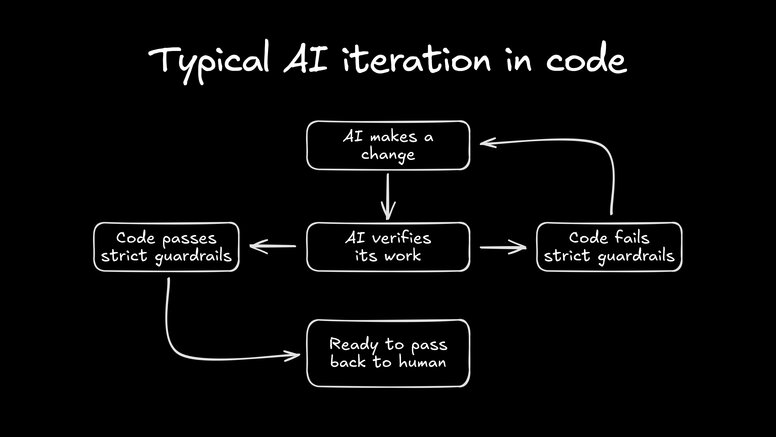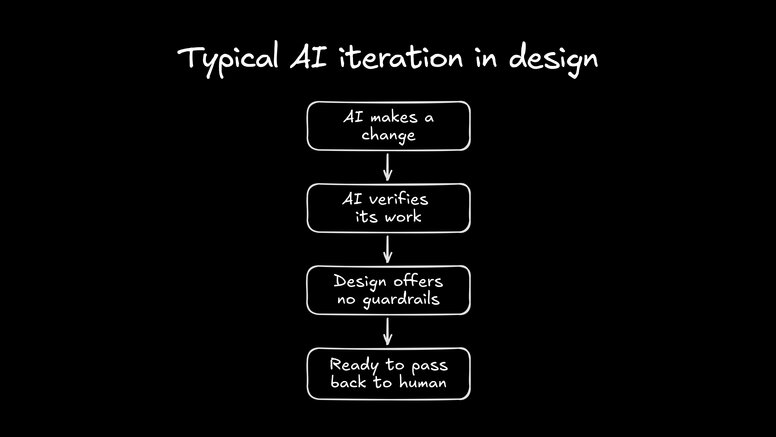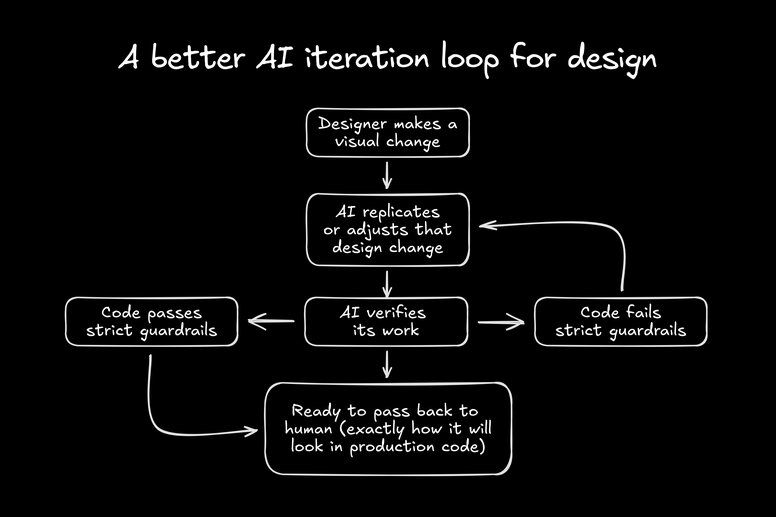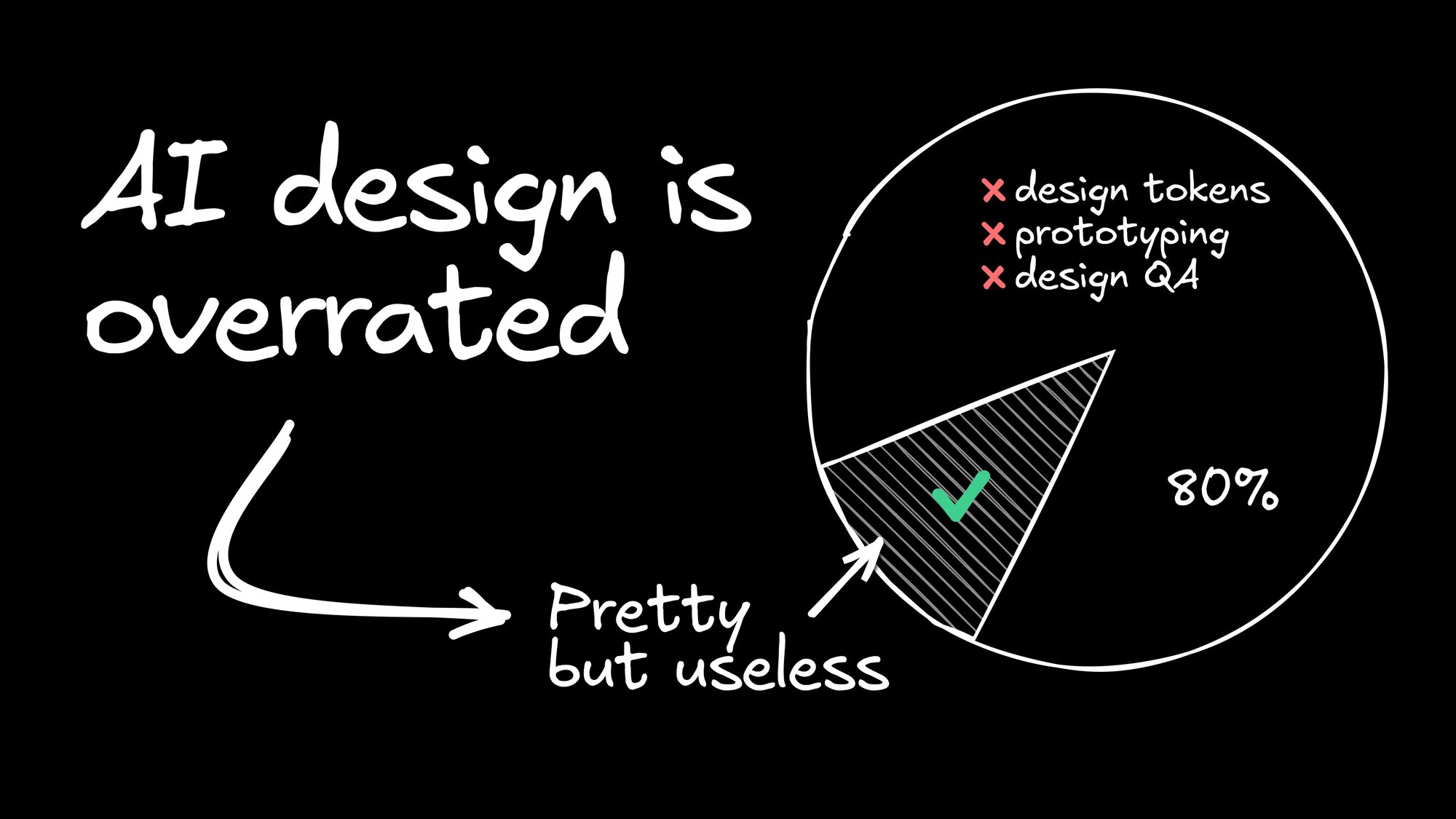AI design tools are everywhere now. If you’re a designer, you’ve probably used a handful of them to erase a background, clean up a layer stack, or power through a tedious round of resizing.
Some features genuinely speed things up, but a lot of the biggest “design for you” promises bring way more clutter than insight.
Let’s break down why design is so hard for AI and where it can actually help.
AI’s sweet spot is anything that runs on clear rules.
Think about tedious, repeatable work, like changing all the font sizes to match a new style guide, tidying up layer names, or cleaning up color swatches that snuck in from old projects. This is the “left-brained” side of design, and machines do great here because every fix follows a recipe: if it doesn’t match, it needs to be fixed.
Development is full of boring clean-up jobs, kinda like erasing the background of a photo. Since way before modern AI, developers have been leaning on automation to keep code tidy, check for bugs, and handle thousands of details no one wants to fuss over.
These hard-coded rules in code give AI agents something to iterate against, so that by the time the developer sees the result, it’s already functional or even complete.

But design isn’t really about neat files and pixel-perfect icons. The real fun starts when the rules become suggestions. Break a grid, stretch a headline, or pick an unexpected color, and your work goes from fine to unforgettable.
Here, there’s no checklist or error alert. AI hits a wall the moment you ask it to chase a vibe, nail a subtle brand feeling, or make a creative leap born from pure intuition. That’s because these are human moves, and they’re what take a design from solid to special.
AI can help keep things tidy and match the system, but when it’s time to work outside the lines, it needs a real designer in the driver’s seat.

AI handles grammar, syntax, and even basic writing style because each correction relies on well-defined patterns, such as catching typos or fixing awkward sentences in a writer’s draft.
Plus, when you work with AI in a writing tool, you’re always in the loop. You prompt, edit, and guide in natural language. You steer the conversation in the same medium as the desired output.
In design, this built-in feedback loop is missing from most AI tools. Instead of responding to your visual moves on a canvas, they expect you to describe your intent in words... and then spend all your time fixing what the AI thought you meant. Prompt fatigue is real.
For AI to actually help with design, it has to be looped into visual editing. It needs to watch your (very human, creative) choices and pick up your intent from each pixel shift or layout twist.
Most AI tools get marketed as replacements for designers, which misses the point entirely. Big promises—press a button, get a finished layout, skip hours of tinkering—sound appealing until you open tools like Figma First Draft or Canva Magic Design and realize the “magic” is usually a pile of generic elements, often disconnected from your brand or vision.
The problem is, instead of organizing your work for the next round, most AI tools encourage duplicating over componentizing and layering. After every “auto” option, you’re left cleaning up messy layers, copy-pasted elements, forgotten color swatches, and components that should’ve been reused but aren’t.
When tools crowd your workspace with disconnected scraps, your intent gets diluted and your flow grinds to a halt.
Designers need smart reuse, clear hierarchy, and tools that help keep things maintainable. That’s code’s advantage, and it’s where design tech needs to go.
Picture this: you open your tool, start moving elements, and your visual edits update the real website live.
You don’t have to type prompts, guess at what the final will look like, or jump through extra handoff hoops. Every shift, resize, and style update lands instantly, with brand intent intact.
The AI doesn’t pitch ideas over the fence or clutter up your file with half-finished templates. It follows your lead, tidying the workspace, snapping details into place, and staying invisible unless you need an extra hand.
Your creative choices, the ones that set the vibe or break a rule on purpose, actually show up in production the way you build them.
This, fundamentally, is our goal for designers using Fusion. And we can do that by integrating with your existing design system.

Design systems and component libraries are the backbone of modern product teams. When you build with reusable components, like buttons, cards, and navbars, you get consistency across your whole product. Brand colors don’t drift, layouts stay tidy, and a single fix updates everywhere it’s used. This is how the best teams scale design while keeping everything on-brand.
AI’s biggest win in design isn’t about creating things from scratch; it’s about working inside these systems. When AI understands your component library and design tokens, it can instantly pull in the right pieces, organize layers, and keep all your updates perfectly synced.
That’s the real answer to design clutter: component-based edits that stay tidy and get deployed everywhere instead of endless copying and pasting.
Designing in code means edits are non-destructive and always consistent. This is exactly what Fusion unlocks: every visual change you make instantly updates in code, keeps your system tight, and removes the headache of manual cleanup.
Fusion flips the script for designers working in code. Instead of asking for prompts or generating artifacts you have to reconcile, Fusion keeps you in your natural workflow.
You move, resize, and arrange real components on a live canvas. Every change you make gets instantly applied to your real codebase (in draft mode), mapped to the design system your team lives by.
What makes Fusion different is how it interprets your creative intent. When you make a visual edit, like scaling up a hero headline, breaking a grid, or swapping out a button, Fusion’s AI pays attention to the differences between your edit and what was there before.
It writes those changes directly to code that your developers can review, keeping everything clean, brand-consistent, and easy to manage.
The interface stays lean. Fusion organizes layers, enforces system logic, and keeps your workspace free from clutter. You get to focus on the fun, rule-breaking side of design while the AI handles the rest.
You don’t have to worry about disconnected mockups, inaccurate handoffs, and long review cycles. You design visually, Fusion “listens” to those moves, and your edits get reflected in the live product with clean, reusable components pulled straight from your library.
Great design happens when tools get out of the way and let you work how you want. Creative intent is amplified (not automated) when you stay in control of your craft.
Ready to see design tools that actually respect your process? Try Fusion and explore a better way to create.
Builder.io visually edits code, uses your design system, and sends pull requests.
Builder.io visually edits code, uses your design system, and sends pull requests.




 Connect a Repo
Connect a Repo











